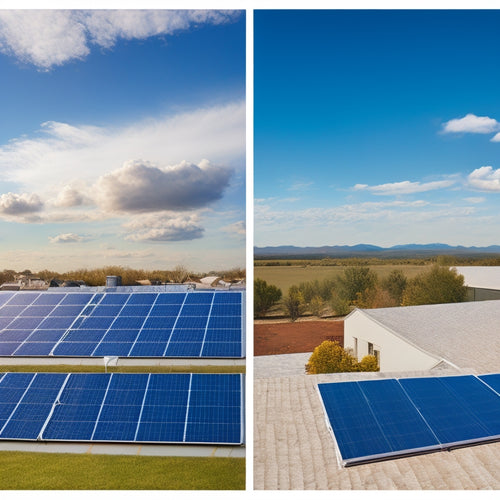
5 Steps to Clean Solar Panels for Maximum Efficiency
Share
You can enhance your solar panel's energy output by cleaning them regularly, and it's easier than you think. To get started, prepare your cleaning equipment and supplies, including a soft-bristled brush, deionized water, and a microfiber cloth. Next, remove debris and loose dirt with a sweep or a dry cloth. Mix a cleaning solution with the right water temperature for your panel's needs, and then clean the panels thoroughly with gentle circular motions. Finally, inspect and dry the panels to guarantee a streak-free finish. By following these 5 steps, you'll be on your way to maximizing your solar panel's efficiency - and there's more to learn about optimizing its performance.
Key Takeaways
- Prepare cleaning equipment, including a soft-bristled brush, deionized water, microfiber cloth, and water-fed pole system for hard-to-reach panels.
- Remove debris and loose dirt using a soft-bristled brush or low-setting leaf blower, and wipe clean with a dry, soft cloth or sponge.
- Mix a cleaning solution with a 1:10 ratio of solution to water, and use distilled or deionized water to prevent mineral buildup.
- Clean solar panels thoroughly using gentle circular motions, starting from the top and working downwards, and apply more pressure for stubborn stains.
- Inspect and dry the panels using a soft, lint-free cloth, and check for signs of damage, loose connections, corrosion, or pest infestation.
Prepare Cleaning Equipment and Supplies
With your solar panels in need of cleaning, gather the necessary equipment and supplies to get the job done efficiently.
You'll need a soft-bristled brush or a specialized solar panel cleaning brush, a bucket of deionized water, a microfiber cloth or squeegee, and a mild soap or cleaning solution specifically designed for solar panels.
Consider investing in a water-fed pole system for hard-to-reach panels. Always prioritize safety precautions when cleaning your solar panels, ensuring a secure ladder or scaffolding system and wearing non-conductive gloves and safety glasses.
Determine the ideal cleaning frequency for your solar panels based on local environmental conditions. If you live in an area with high levels of pollution, dust, or debris, you may need to clean your panels more frequently.
Typically, cleaning every 6-12 months is sufficient, but it's crucial to monitor your energy output and adjust your cleaning schedule accordingly.
Remove Debris and Loose Dirt
Frequently, solar panels accumulate debris and loose dirt, which can greatly reduce their energy output. This debris can range from leaves, twigs, and branches to bird droppings, dust, and sand. If left unchecked, these debris types can block sunlight and decrease your solar panel's energy production.
To remove debris and loose dirt, start by gently sweeping the surface of the solar panels with a soft-bristled brush or a leaf blower on a low setting. This will loosen and remove any large debris.
Next, use a dry, soft cloth or sponge to wipe away any remaining dirt and debris. Be sure to wipe in a straight line, following the direction of the panel's frame, to avoid scratching the surface.
Remove any stubborn dirt or debris by hand, taking care not to apply too much pressure. Complete the dirt removal process by visually inspecting the panels to verify all debris has been removed.
With the debris and dirt removed, you're ready to move on to the next step in the cleaning process.
Mix Water and Cleaning Solution
Now that your solar panels are free of debris and loose dirt, you're ready to tackle the next step in the cleaning process. Mixing water and cleaning solution is an important step to guarantee your solar panels are cleaned effectively and safely.
When mixing water and cleaning solution, it's vital to use the right proportion to avoid damaging your solar panels. A general rule of thumb is to use 1 part cleaning solution to 10 parts water. However, this ratio may vary depending on the type of cleaning solution you're using, so make sure to check the manufacturer's instructions.
Here's a table to help you determine the right water temperature for your cleaning solution:
| Water Temperature | Cleaning Solution | Purpose |
|---|---|---|
| Cold water (below 40°F) | Mild detergent | General cleaning |
| Lukewarm water (40°F - 80°F) | Standard cleaning solution | Average dirt buildup |
| Warm water (80°F - 100°F) | Heavy-duty cleaning solution | Heavy dirt buildup |
| Hot water (above 100°F) | Avoid using | Can damage solar panels |
Remember to always use distilled or deionized water to prevent mineral buildup on your solar panels. By mixing the right cleaning solution with water at the correct temperature, you'll be able to effectively clean your solar panels without damaging them.
Clean Solar Panels Thoroughly
Your soft-bristled brush is ready to get to work, scrubbing away the dirt and grime that's hindering your solar panels' performance. Start at the top of the panel and work your way down, using gentle circular motions to remove debris.
Be sure to clean the entire surface, including the frames and corners, where dirt often accumulates. For more stubborn stains, you can apply a bit more pressure, but avoid using abrasive materials that can scratch the panels.
Regular cleaning is essential for solar panel maintenance, as dirty panels can reduce energy output by up to 25%. The cleaning frequency will depend on your location and climate, but as a general rule, clean your panels every 6-12 months.
If you live in a dusty or polluted area, you may need to clean them more frequently. As you clean, pay attention to any areas with heavy buildup, as this can indicate a need for more frequent cleaning.
Inspect and Dry the Panels
After scrubbing away the dirt and grime, you're ready to inspect and dry the panels. This step is essential to guarantee maximum efficiency and extend the lifespan of your solar panels.
Begin by visually inspecting the panels for any remaining debris or streaks. Check for signs of damage, such as cracks or broken glass, and make a note of any areas that need repair.
Take necessary safety precautions when inspecting the panels, including wearing protective gear like gloves and safety glasses. Also, avoid touching the panels' surface, as oils from your skin can attract dirt and reduce efficiency.
Use a soft, lint-free cloth or microfiber towel to dry the panels, starting from the top and working your way down. This will prevent water spots from forming.
Inspection tips: check for loose connections, corrosion, or signs of pest infestation. A thorough inspection and drying process will assure your solar panels are in top condition, ready to utilize maximum energy from the sun.
Frequently Asked Questions
Can I Clean Solar Panels During Peak Sun Hours?
You shouldn't clean your solar panels during peak sun hours, as it can cause water to evaporate too quickly, reducing the effectiveness of solar panel cleaning and potentially leaving streaks or spots, hindering the best cleaning methods.
How Often Should I Clean Solar Panels in Dusty Areas?
You should clean solar panels every 2-4 weeks in dusty areas to maintain peak energy output, as neglecting regular cleaning can lead to 15-20% energy loss; adjust your cleaning frequency based on local environmental conditions for effective maintenance tips.
Will Rain Clean My Solar Panels Effectively?
Imagine a rainy day in Munich, Germany, where solar panels receive 90% of their monthly rainfall in just 2 hours; you'll benefit from rain cleaning your panels, but in dusty areas, you'll still need to clean them every 2-3 months to maintain peak efficiency.
Can I Use a Pressure Washer to Clean Solar Panels?
You're wondering if you can use a pressure washer to clean your solar panels? Be cautious: high pressure can damage panels, so make certain you use a wide fan tip, keep the nozzle at least 12 inches away, and adopt gentle cleaning techniques for safety.
Do I Need to Clean the Entire Solar Panel System?
Savvy solar enthusiasts, you're wise to wonder if entire system scrubbing is necessary. Typically, you'll focus on panel maintenance, targeting areas with high dirt buildup, and utilizing specialized cleaning tools to guarantee peak energy harvesting without unnecessary effort.
Related Posts
-

Master Advanced Solar Panel Design Online for Free
You can master advanced solar panel design online for free by leveraging specialized courses and training platforms, ...
-

Planning for an Electric Vehicle-Friendly Urban Future
As you plan for an electric vehicle-friendly urban future, you'll need to integrate high-power charging stations, sma...
-

Tracking Solar Panels Vs Fixed Panels Cost Savings
When considering solar panel options, you'll want to weigh the cost savings of tracking solar panels versus fixed pan...


